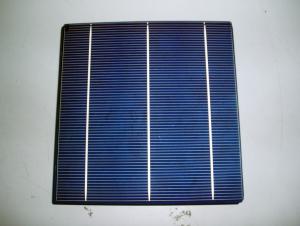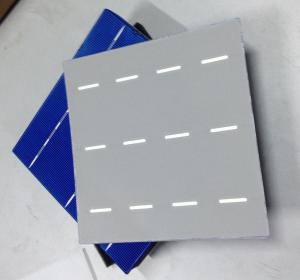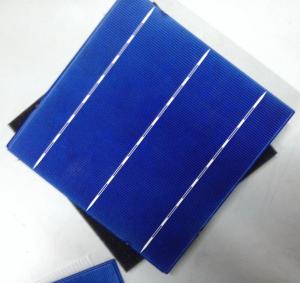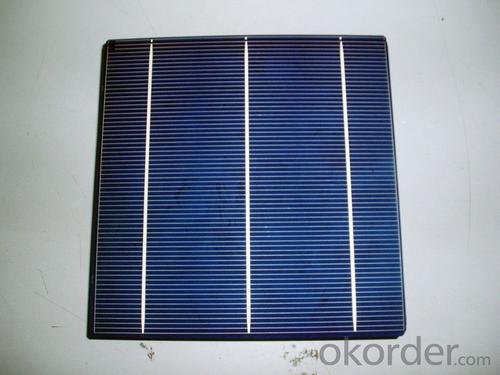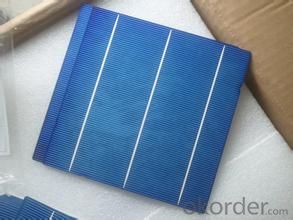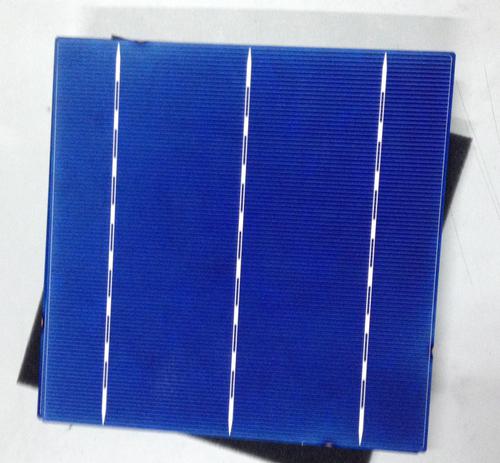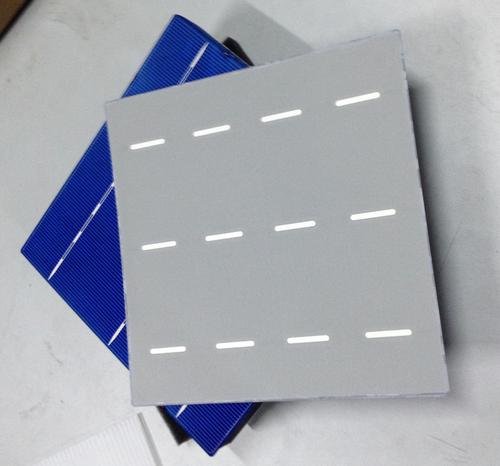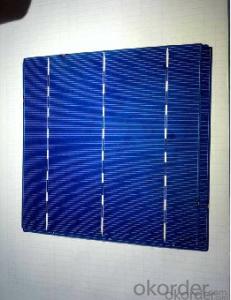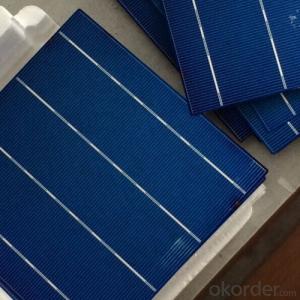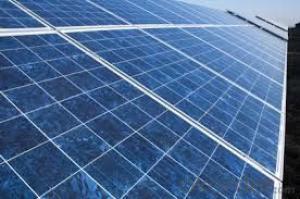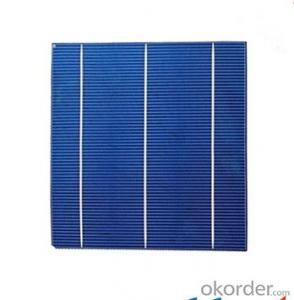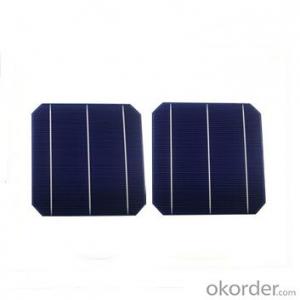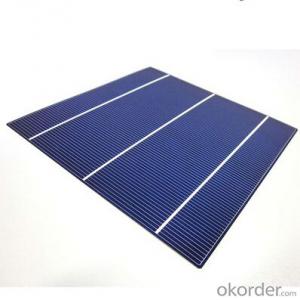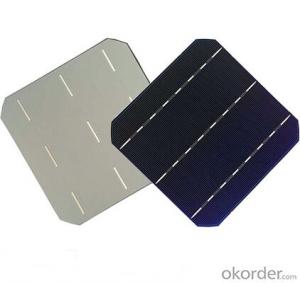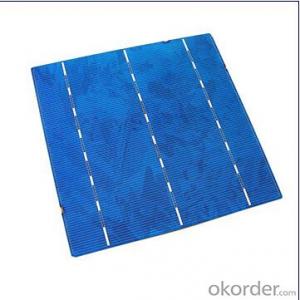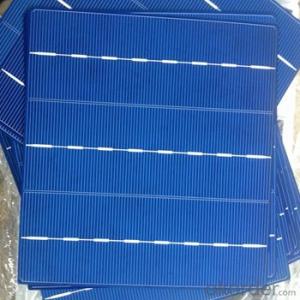III-V Solar Cells - Polycrystalline Solar Cells, Good Quality, Stable Supply, 17.4% Efficiency
- Loading Port:
- China Main Port
- Payment Terms:
- TT or LC
- Min Order Qty:
- 5000 pc
- Supply Capability:
- -
OKorder Service Pledge
OKorder Financial Service
You Might Also Like
Brief Introduction of Solar Cells
A solar cell, is an electrical device that converts the energy of light directly into electricity by the photovoltaic effect, which is a physical and chemical phenomenon. It is a form of photoelectric cell, defined as a device whose electrical characteristics, such as current, voltage, or resistance, vary when exposed to light. Solar cells are the building blocks of photovoltaic modules, otherwise known as solar panels.
Specifications of Polycrystalline Solar Cells
Format : 156 mm × 156 mm ± 0.5 mm
Thickness: 210 μm ±40 μm
Front (-) : 1.5mm bus bars (silver),blue anti-reflection coating (silicon nitride)
Back (+) : 2.5mm wide soldering pads (silver) back surface field (aluminium)
Efficiency (%) | Pmpp (W) | Umpp (V) | Impp (A) | Voc (V) | Isc (A) |
18.00% | 4.38 | 0.528 | 8.291 | 0.631 | 8.869 |
17.80% | 4.33 | 0.525 | 8.252 | 0.629 | 8.821 |
17.60% | 4.29 | 0.532 | 8.053 | 0.633 | 8.541 |
17.40% | 4.23 | 0.528 | 8.092 | 0.624 | 8.632 |
17.20% | 4.19 | 0.524 | 7.992 | 0.62 | 8.458 |
17.00% | 4.14 | 0.52 | 7.972 | 0.623 | 8.5 |
Advantage of Polycrystalline Solar Cells
Tire-1 Solar Cells’ Manufacturer Quality Guarantee. With a complete and sophisticated quality government system, our Quality Management have arrived world’s leading place. Customer can receive Tire-1 Cells Maker’s Quality Standard Products.
Trusted Warranty. We can supply trusted after-sales service to our customer. If our cells are found not in conformity to the specification of manufacturer, or should the inspected quantity found in shortage, or should the packing found damaged, the buyer has the right to claim to the seller. The claim, if any, should be presented to seller within 30 days after cargo's arrival date to the port, together with related inspection report and photos issued and provided by a reputable independent surveyor such as SGS.
World’s Leading Manufacturer Equipment. We imported the newest and leading production equipment from abroad. Advanced equipment can guarantee the stable quality of cells. Auto production line can also save labor cost which will further cut our production cost.
Bulk supply: With the production capacity of 500MW, we can produce large quantity every month. This can satisfy most customer requirement.
Usage of Polycrystalline Solar Cells
Solar cells are often electrically connected and encapsulated as a module. Photovoltaic modules often have a sheet of glass on the front (sun up) side, allowing light to pass while protecting the semiconductor wafers from abrasion and impact due to wind-driven debris, rain, hail, etc. Solar cells are also usually connected in series in modules, creating an additive voltage. Connecting cells in parallel will yield a higher current; our solar cells have passed IEC Certification. With high and stable quality, our cells can greatly improve the performance of Solar Modules.
Applications of Polycrystalline Solar Cells
Assemblies of photovoltaic cells are used to make solar modules which generate electrical power from sunlight, as distinguished from a "solar module" or "solar panel". A solar array generates solar power using solar energy.
Packaging & Delivery of Polycrystalline Solar Cells
Carton Box Package and Deliver by air. It should be noticed that it should be avoid of water, sunshine and moist.
Factory Picture of Solar Cells
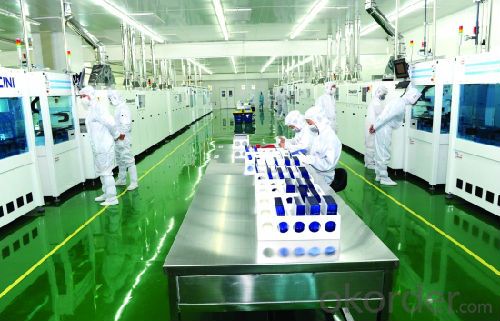
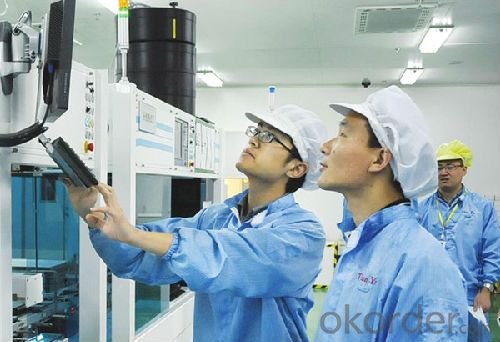
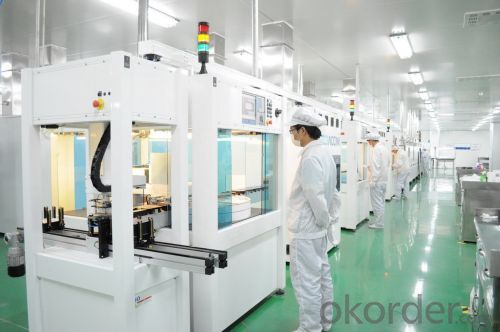
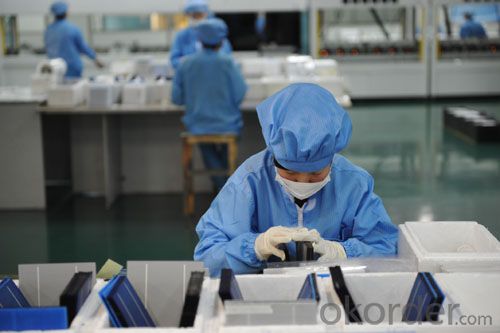
FAQ
We have organized several common questions for our clients,may help you sincerely:
1. What’s price per Watt?
A: It’s depends on the quantity, delivery date and payment terms of the order. We can talk further about the detail price issue. Our products is high quality with lower price level.
2. Can you tell me the parameter of your solar cells?
We have different series of cells with different power output, both from c-si to a-si. Please take our specification sheet for your reference.
3.How do you pack your products?
We have rich experience on how to pack the panels to make sure the safety on shipment when it arrives at the destination.
4.Can you do OEM for us?
Yes, we can.
5.How long can we receive the product after purchase?
In the purchase of product within three working days, We will arrange the factory delivery as soon as possible. The perfect time of receiving is related to the state and position of customers. Commonly 7 to 10 working days can be served.
- Q: Are solar cells affected by temperature?
- Yes, solar cells are indeed affected by temperature. High temperatures can cause a decrease in the efficiency of solar cells, resulting in reduced power output. Conversely, low temperatures can sometimes lead to a slight increase in efficiency.
- Q: How do solar cells perform in areas with high levels of air pollutants?
- Solar cells may experience a decrease in performance in areas with high levels of air pollutants due to reduced sunlight reaching the surface. The presence of pollutants such as smog and particulate matter can block and scatter sunlight, thereby reducing the efficiency of solar cells. Regular cleaning and maintenance of solar panels can help mitigate the impact of air pollutants and ensure optimal performance.
- Q: Can solar cells be used on airplanes?
- Yes, solar cells can be used on airplanes. In recent years, there has been a rise in the use of solar cells to power various aircraft systems, such as auxiliary power units and cabin lighting. Additionally, there have been successful attempts to develop solar-powered unmanned aerial vehicles (UAVs) that can fly for extended periods using solar energy. However, due to the limited surface area available on airplanes and the current efficiency of solar cells, it is not yet feasible to solely rely on solar power for the propulsion of large commercial aircraft.
- Q: What is the impact of tree shading on solar cell efficiency?
- Tree shading can significantly reduce solar cell efficiency as it blocks sunlight from reaching the surface of the cells. This shading creates patches of shade on the solar panels, reducing the overall output of electricity. It is important to ensure that solar panels are installed in areas with minimal shading to maximize their efficiency and energy generation.
- Q: Can solar cells be used in water?
- Yes, solar cells can be used in water. However, it is important to note that the efficiency of solar cells decreases when submerged in water due to reduced sunlight penetration. Additionally, precautions must be taken to ensure the waterproofing and insulation of the solar cells to prevent any damage or electrical hazards.
- Q: Can solar cells be used to power remote transportation systems?
- Yes, solar cells can be used to power remote transportation systems. Solar cells are a reliable and sustainable source of renewable energy that can be installed on vehicles or infrastructure to provide power for electric motors, batteries, or other components. This allows remote transportation systems such as electric cars, boats, or drones to operate efficiently without relying on fossil fuels or traditional power grids, making them more environmentally friendly and cost-effective in remote areas.
- Q: Can solar cells be used in greenhouses?
- Yes, solar cells can be used in greenhouses to generate electricity and power various systems within the greenhouse, such as lighting, ventilation, and irrigation. This helps reduce the reliance on traditional energy sources and promotes sustainable and eco-friendly practices in greenhouse farming.
- Q: Can solar cells be used for powering mining operations?
- Yes, solar cells can be used for powering mining operations. Solar energy can be harnessed and converted into electricity using solar cells, which can then be used to power various mining equipment and operations. This renewable energy source can help reduce the dependence on fossil fuels, lower operational costs, and have a positive environmental impact on mining activities.
- Q: Can solar cells be used to power streetlights?
- Yes, solar cells can be used to power streetlights. Solar-powered streetlights utilize solar panels to convert sunlight into electricity, which is then stored in batteries to power the lights during nighttime. This renewable energy source is cost-effective and environmentally friendly, making it a popular choice for street lighting in many areas.
- Q: Can solar cells be used in drones?
- Yes, solar cells can be used in drones. Solar-powered drones utilize photovoltaic cells to convert sunlight into electricity, which is then used to power the drone's propulsion system and other onboard equipment. This allows drones to have extended flight times and reduces reliance on traditional battery power.
Send your message to us
III-V Solar Cells - Polycrystalline Solar Cells, Good Quality, Stable Supply, 17.4% Efficiency
- Loading Port:
- China Main Port
- Payment Terms:
- TT or LC
- Min Order Qty:
- 5000 pc
- Supply Capability:
- -
OKorder Service Pledge
OKorder Financial Service
Similar products
Hot products
Hot Searches
Related keywords
